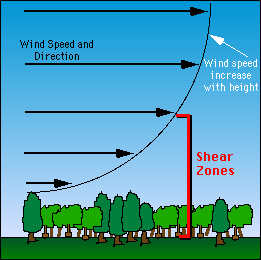Buoyancy has a significant influence on mixing in the PBL. In fact, convective turbulence is due to the fact that warmer air is more buoyant than cooler air, allowing it to rise and mix with surrounding air. During the day, air in the mixed layer is regularly being convected upwards (if the air is sufficiently unstable). At night, the air in the stable boundary layer is not buoyant. Turbulence and vertical motion in the nocturnal boundary layer are, therefore, due mostly to eddy turbulence and shear.

Wind shear is the change in the direction and/or magnitude of wind with height. If the wind shear is large enough, turbulence is produced. A rapid change in wind speed or direction allows eddies to split away from the general flow. Shears are often formed due to friction with the rough surface of the earth. This allows slower winds near the surface and faster wind aloft. Thus, a shear is created. The more rough a surface, the greater the wind shear. In the diagram to the right, notice the exponential curve that connects the wind vector tips. This shows the dramatic increase in wind velocity near the surface. However, further up, the wind speed does not increase rapidly with height. Therefore, the greatest shear is created near the surface.
Scientists use a parameter to describe the degree of roughness of the earth's surface, which is called the aerodynamic roughness length, which generally has the symbol z0 It has magnitudes on the order of a few centimeters over grass and crops, and a few meters over forests and towns. The roughness length is based on the size and distance between objects in a group. A field of short grass will have a smaller z0 than tall grass. A city with skyscrapers will have a larger z0 than a small town. The roughness length is important in determining wind shears over a surface, and influences turbulence development in the PBL.
Roughness Lengths for Various Surfaces
| Type of Surface | z0 (cm) |
|---|
| Fir Forest | 283.0 |
| Citrus orchard | 198.0 |
| Large City (Tokyo) | 165.0 |
| Corn Field | 84.5 |
| Wheat Field | 23.0 |
| Grass | 10.0 |
| Dry Lake Bed | 0.003 |




Developed by
 The Shodor
Education Foundation, Inc.
The Shodor
Education Foundation, Inc.
Copyright © 1996


 The Shodor
Education Foundation, Inc.
The Shodor
Education Foundation, Inc.